Abstract
1. The nitric oxide (NO)-releasing properties of two new mesoionic 3-aryl substituted oxatriazole-5-imine derivatives (GEA 3162 and GEA 3175) were characterized and compared with the known NO-donors 3-morpholino-sydnonimine (SIN-1) and S-nitroso-N-acetylpenicillamine (SNAP). 2. GEA 3162, GEA 3175, SIN-1 and SNAP inhibited adenosine 5'-diphosphate-induced platelet aggregation (IC50 values 0.18, 0.39, 3.73 and 2.12 microM, respectively). All four compounds induced a dose-dependent and more than 4 fold increase in cyclic GMP in platelets. The increase in cyclic GMP concentration was potentiated more than 1.5 fold by a phosphodiesterase inhibitor, zaprinast (10 microM) and inhibited 38-97% by oxyhaemoglobin (10-45 microM). 3. All of the four compounds studied converted oxyhaemoglobin to methaemoglobin and formed a paramagnetic NO-haemoglobin complex. All but GEA 3175 formed nitrite and nitrate in phosphate buffer. During a 40 min incubation, GEA 3162, SIN-1 and SNAP (100 microM) produced 50-70 microM NO2- + NO3- as determined by high performance liquid chromatography. The release of NO and NO2 by GEA 3175 was increased 140 fold in the presence of human plasma (0.14 and 19.7 ppb in the absence and presence of 1% human plasma, respectively) as analyzed by ozone chemiluminescence. 4. The results suggest that the mesoionic 3-aryl substituted oxatriazole-5-imine derivatives GEA 3162 and GEA 3175 as well as SIN-1 and SNAP release nitric oxide.
Full text
PDF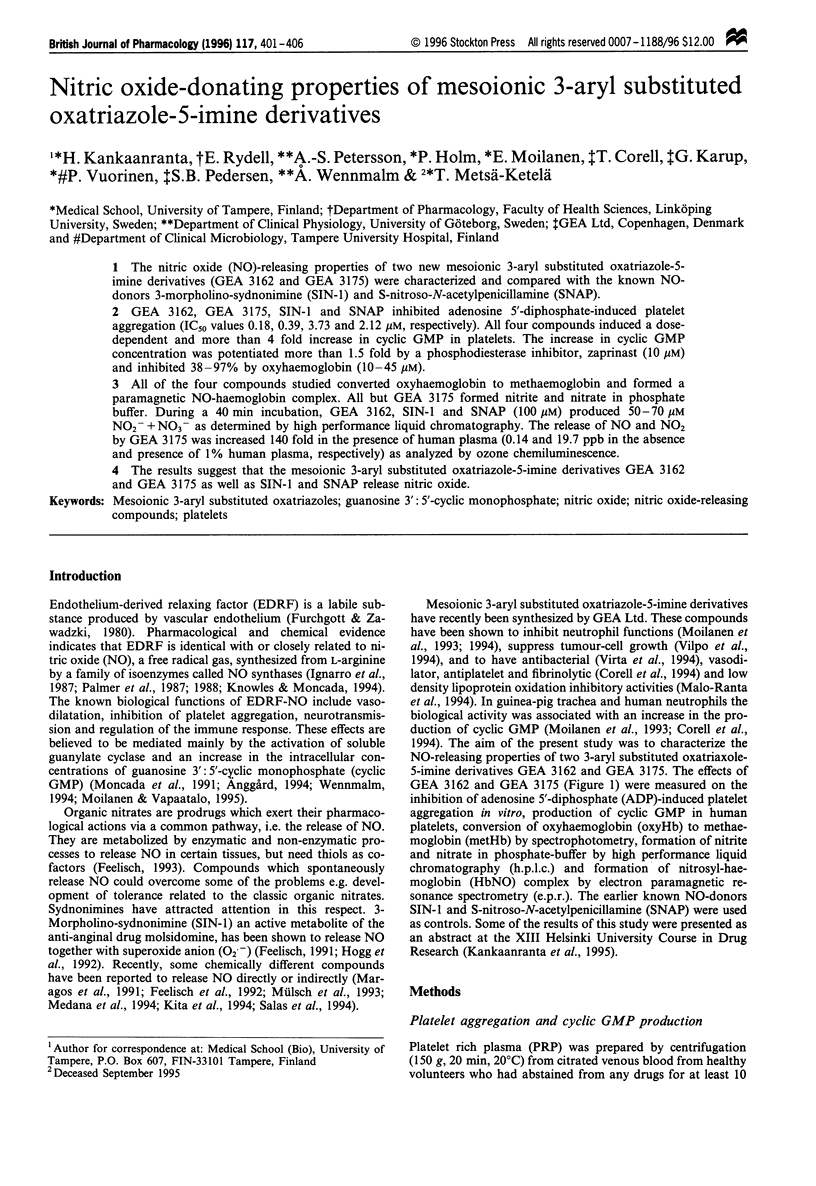
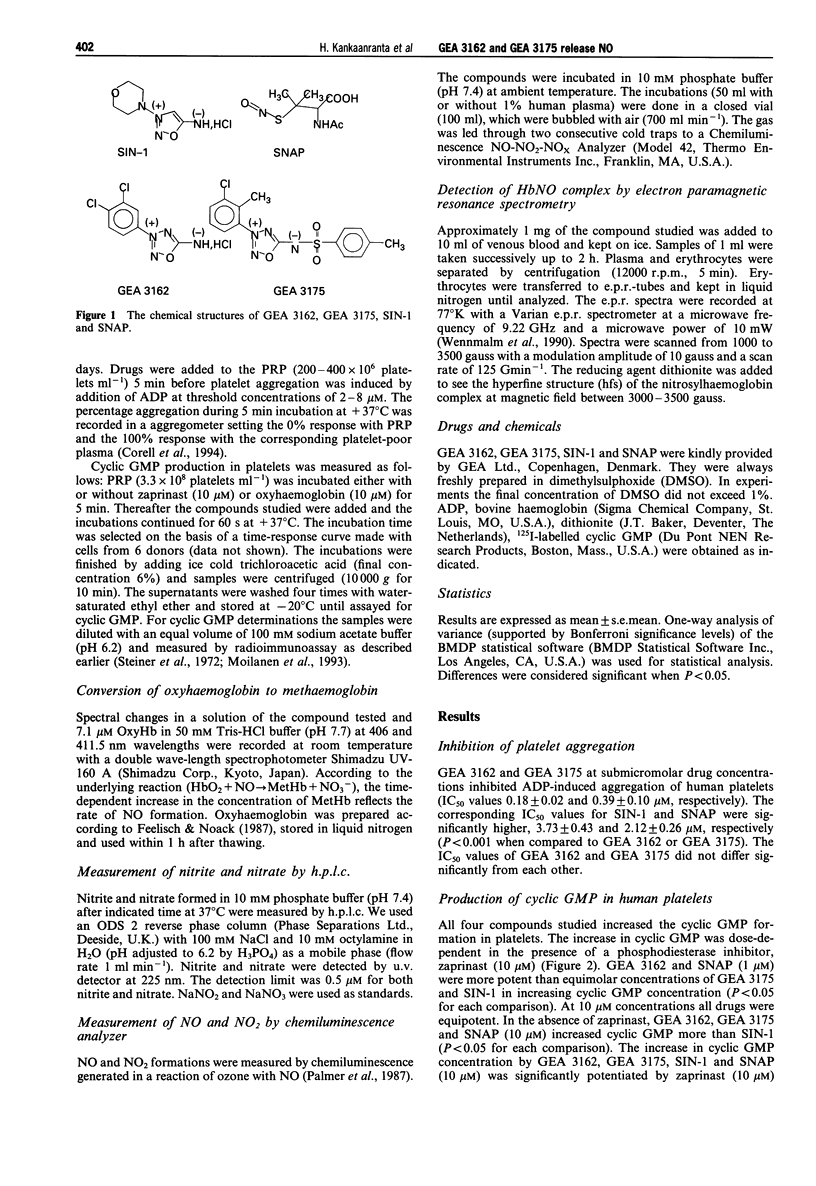
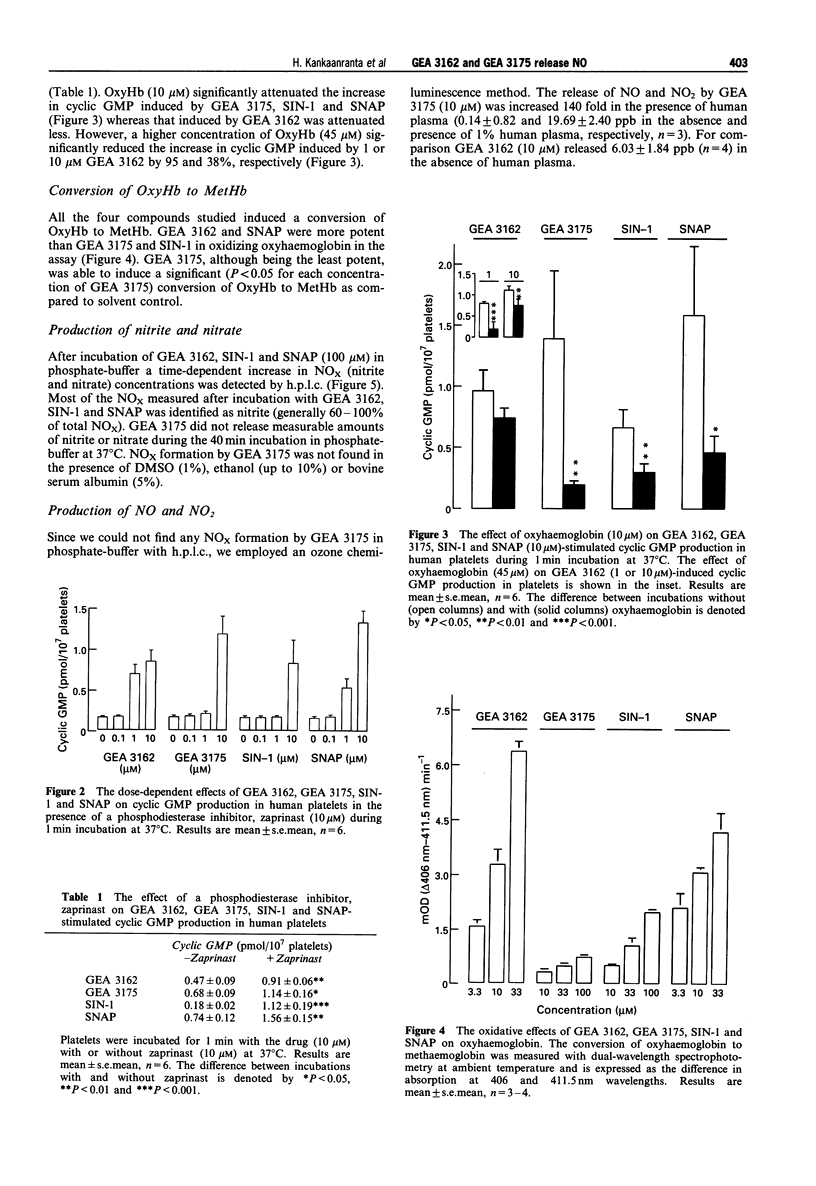
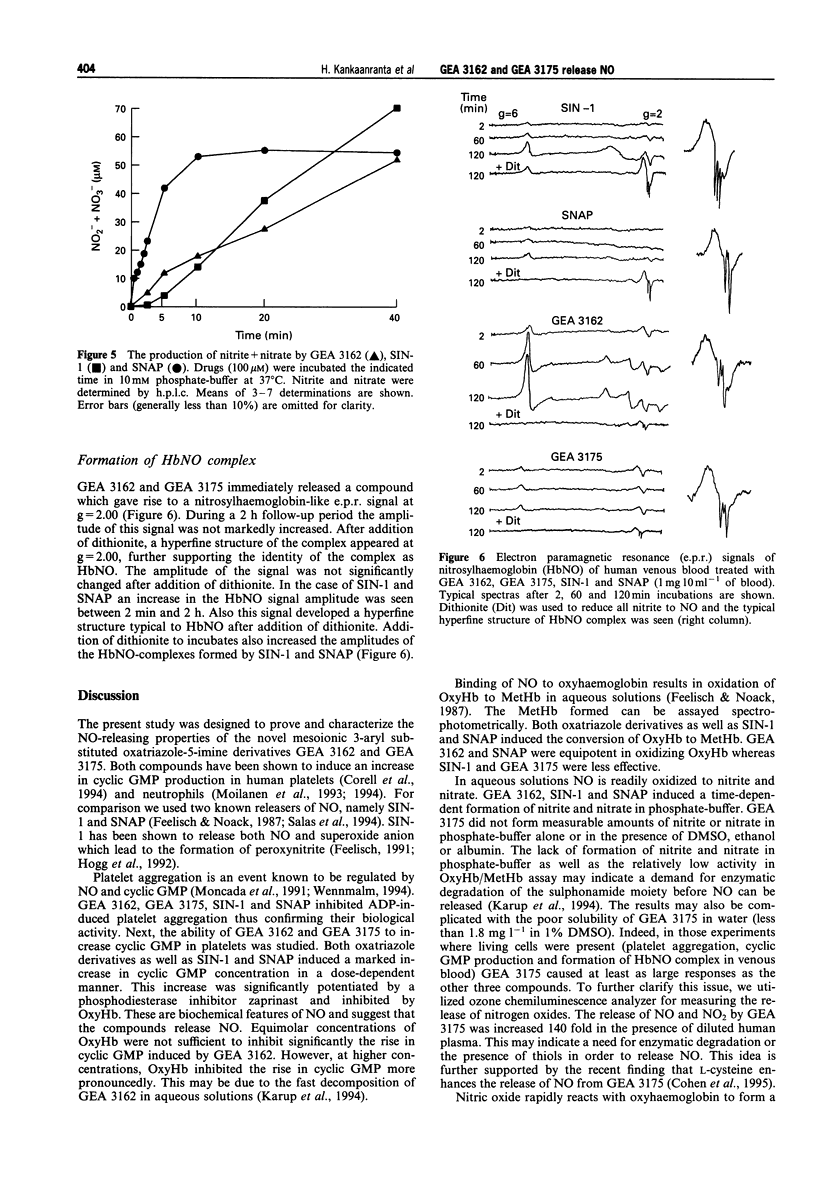
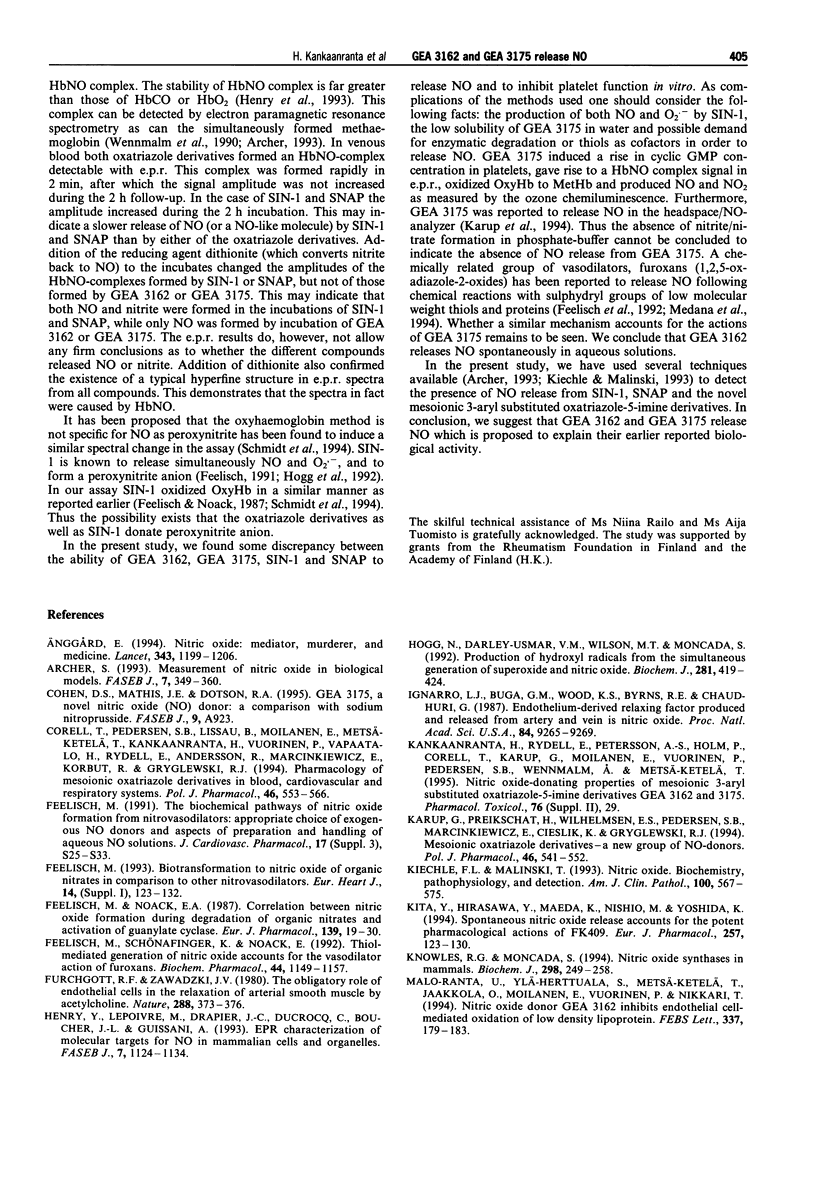
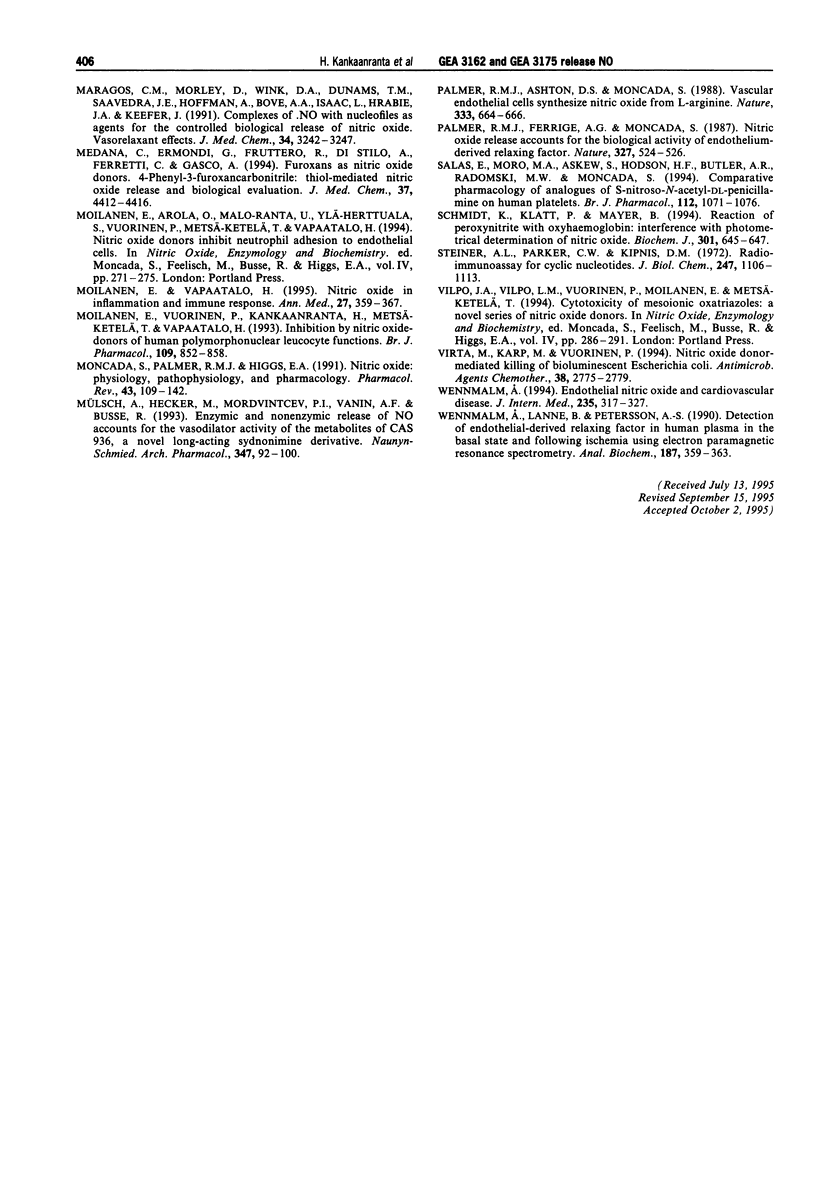
Selected References
These references are in PubMed. This may not be the complete list of references from this article.
- Anggård E. Nitric oxide: mediator, murderer, and medicine. Lancet. 1994 May 14;343(8907):1199–1206. doi: 10.1016/s0140-6736(94)92405-8. [DOI] [PubMed] [Google Scholar]
- Archer S. Measurement of nitric oxide in biological models. FASEB J. 1993 Feb 1;7(2):349–360. doi: 10.1096/fasebj.7.2.8440411. [DOI] [PubMed] [Google Scholar]
- Corell T., Pedersen S. B., Lissau B., Moilanen E., Metsä-Ketelä T., Kankaanranta H., Vuorinen P., Vapaatalo H., Rydell E., Andersson R. Pharmacology of mesoionic oxatriazole derivatives in blood, cardiovascular and respiratory systems. Pol J Pharmacol. 1994 Nov-Dec;46(6):553–566. [PubMed] [Google Scholar]
- Feelisch M. Biotransformation to nitric oxide of organic nitrates in comparison to other nitrovasodilators. Eur Heart J. 1993 Nov;14 (Suppl 1):123–132. [PubMed] [Google Scholar]
- Feelisch M., Noack E. A. Correlation between nitric oxide formation during degradation of organic nitrates and activation of guanylate cyclase. Eur J Pharmacol. 1987 Jul 2;139(1):19–30. doi: 10.1016/0014-2999(87)90493-6. [DOI] [PubMed] [Google Scholar]
- Feelisch M., Schönafinger K., Noack E. Thiol-mediated generation of nitric oxide accounts for the vasodilator action of furoxans. Biochem Pharmacol. 1992 Sep 25;44(6):1149–1157. doi: 10.1016/0006-2952(92)90379-w. [DOI] [PubMed] [Google Scholar]
- Furchgott R. F., Zawadzki J. V. The obligatory role of endothelial cells in the relaxation of arterial smooth muscle by acetylcholine. Nature. 1980 Nov 27;288(5789):373–376. doi: 10.1038/288373a0. [DOI] [PubMed] [Google Scholar]
- Henry Y., Lepoivre M., Drapier J. C., Ducrocq C., Boucher J. L., Guissani A. EPR characterization of molecular targets for NO in mammalian cells and organelles. FASEB J. 1993 Sep;7(12):1124–1134. doi: 10.1096/fasebj.7.12.8397130. [DOI] [PubMed] [Google Scholar]
- Hogg N., Darley-Usmar V. M., Wilson M. T., Moncada S. Production of hydroxyl radicals from the simultaneous generation of superoxide and nitric oxide. Biochem J. 1992 Jan 15;281(Pt 2):419–424. doi: 10.1042/bj2810419. [DOI] [PMC free article] [PubMed] [Google Scholar]
- Ignarro L. J., Buga G. M., Wood K. S., Byrns R. E., Chaudhuri G. Endothelium-derived relaxing factor produced and released from artery and vein is nitric oxide. Proc Natl Acad Sci U S A. 1987 Dec;84(24):9265–9269. doi: 10.1073/pnas.84.24.9265. [DOI] [PMC free article] [PubMed] [Google Scholar]
- Karup G., Preikschat H., Wilhelmsen E. S., Pedersen S. B., Marcinkiewicz E., Cieślik K., Gryglewski R. J. Mesoionic oxatriazole derivatives--a new group of NO-donors. Pol J Pharmacol. 1994 Nov-Dec;46(6):541–552. [PubMed] [Google Scholar]
- Kiechle F. L., Malinski T. Nitric oxide. Biochemistry, pathophysiology, and detection. Am J Clin Pathol. 1993 Nov;100(5):567–575. doi: 10.1093/ajcp/100.5.567. [DOI] [PubMed] [Google Scholar]
- Kita Y., Hirasawa Y., Maeda K., Nishio M., Yoshida K. Spontaneous nitric oxide release accounts for the potent pharmacological actions of FK409. Eur J Pharmacol. 1994 May 12;257(1-2):123–130. doi: 10.1016/0014-2999(94)90703-x. [DOI] [PubMed] [Google Scholar]
- Knowles R. G., Moncada S. Nitric oxide synthases in mammals. Biochem J. 1994 Mar 1;298(Pt 2):249–258. doi: 10.1042/bj2980249. [DOI] [PMC free article] [PubMed] [Google Scholar]
- Malo-Ranta U., Ylä-Herttuala S., Metsä-Ketelä T., Jaakkola O., Moilanen E., Vuorinen P., Nikkari T. Nitric oxide donor GEA 3162 inhibits endothelial cell-mediated oxidation of low density lipoprotein. FEBS Lett. 1994 Jan 10;337(2):179–183. doi: 10.1016/0014-5793(94)80269-6. [DOI] [PubMed] [Google Scholar]
- Maragos C. M., Morley D., Wink D. A., Dunams T. M., Saavedra J. E., Hoffman A., Bove A. A., Isaac L., Hrabie J. A., Keefer L. K. Complexes of .NO with nucleophiles as agents for the controlled biological release of nitric oxide. Vasorelaxant effects. J Med Chem. 1991 Nov;34(11):3242–3247. doi: 10.1021/jm00115a013. [DOI] [PubMed] [Google Scholar]
- Medana C., Ermondi G., Fruttero R., Di Stilo A., Ferretti C., Gasco A. Furoxans as nitric oxide donors. 4-Phenyl-3-furoxancarbonitrile: thiol-mediated nitric oxide release and biological evaluation. J Med Chem. 1994 Dec 9;37(25):4412–4416. doi: 10.1021/jm00051a020. [DOI] [PubMed] [Google Scholar]
- Moilanen E., Vapaatalo H. Nitric oxide in inflammation and immune response. Ann Med. 1995 Jun;27(3):359–367. doi: 10.3109/07853899509002589. [DOI] [PubMed] [Google Scholar]
- Moilanen E., Vuorinen P., Kankaanranta H., Metsä-Ketelä T., Vapaatalo H. Inhibition by nitric oxide-donors of human polymorphonuclear leucocyte functions. Br J Pharmacol. 1993 Jul;109(3):852–858. doi: 10.1111/j.1476-5381.1993.tb13653.x. [DOI] [PMC free article] [PubMed] [Google Scholar]
- Moncada S., Palmer R. M., Higgs E. A. Nitric oxide: physiology, pathophysiology, and pharmacology. Pharmacol Rev. 1991 Jun;43(2):109–142. [PubMed] [Google Scholar]
- Mülsch A., Hecker M., Mordvintcev P. I., Vanin A. F., Busse R. Enzymic and nonenzymic release of NO accounts for the vasodilator activity of the metabolites of CAS 936, a novel long-acting sydnonimine derivative. Naunyn Schmiedebergs Arch Pharmacol. 1993 Jan;347(1):92–100. doi: 10.1007/BF00168778. [DOI] [PubMed] [Google Scholar]
- Palmer R. M., Ashton D. S., Moncada S. Vascular endothelial cells synthesize nitric oxide from L-arginine. Nature. 1988 Jun 16;333(6174):664–666. doi: 10.1038/333664a0. [DOI] [PubMed] [Google Scholar]
- Palmer R. M., Ferrige A. G., Moncada S. Nitric oxide release accounts for the biological activity of endothelium-derived relaxing factor. Nature. 1987 Jun 11;327(6122):524–526. doi: 10.1038/327524a0. [DOI] [PubMed] [Google Scholar]
- Ross S. B. Heterogenous binding of 3H-remoxipride to membranes of rat liver and brain. Pharmacol Toxicol. 1995 Jan;76(1):29–35. doi: 10.1111/j.1600-0773.1995.tb00098.x. [DOI] [PubMed] [Google Scholar]
- Salas E., Moro M. A., Askew S., Hodson H. F., Butler A. R., Radomski M. W., Moncada S. Comparative pharmacology of analogues of S-nitroso-N-acetyl-DL-penicillamine on human platelets. Br J Pharmacol. 1994 Aug;112(4):1071–1076. doi: 10.1111/j.1476-5381.1994.tb13192.x. [DOI] [PMC free article] [PubMed] [Google Scholar]
- Schmidt K., Klatt P., Mayer B. Reaction of peroxynitrite with oxyhaemoglobin: interference with photometrical determination of nitric oxide. Biochem J. 1994 Aug 1;301(Pt 3):645–647. doi: 10.1042/bj3010645. [DOI] [PMC free article] [PubMed] [Google Scholar]
- Steiner A. L., Parker C. W., Kipnis D. M. Radioimmunoassay for cyclic nucleotides. I. Preparation of antibodies and iodinated cyclic nucleotides. J Biol Chem. 1972 Feb 25;247(4):1106–1113. [PubMed] [Google Scholar]
- Virta M., Karp M., Vuorinen P. Nitric oxide donor-mediated killing of bioluminescent Escherichia coli. Antimicrob Agents Chemother. 1994 Dec;38(12):2775–2779. doi: 10.1128/aac.38.12.2775. [DOI] [PMC free article] [PubMed] [Google Scholar]
- Wennmalm A. Endothelial nitric oxide and cardiovascular disease. J Intern Med. 1994 Apr;235(4):317–327. doi: 10.1111/j.1365-2796.1994.tb01081.x. [DOI] [PubMed] [Google Scholar]
- Wennmalm A., Lanne B., Petersson A. S. Detection of endothelial-derived relaxing factor in human plasma in the basal state and following ischemia using electron paramagnetic resonance spectrometry. Anal Biochem. 1990 Jun;187(2):359–363. doi: 10.1016/0003-2697(90)90470-t. [DOI] [PubMed] [Google Scholar]


